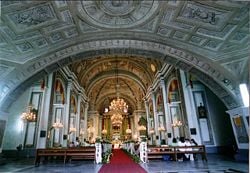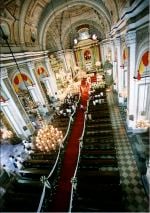Baroque Churches of the Philippines
| Baroque Churches of the Philippines* | |
|---|---|
| UNESCO World Heritage Site | |

| |
| State Party | |
| Type | Cultural |
| Criteria | ii, iv |
| Reference | 677 |
| Region** | Asia-Pacific |
| Inscription history | |
| Inscription | 1993 (17th Session) |
| * Name as inscribed on World Heritage List. ** Region as classified by UNESCO. | |
The Baroque Churches of the Philippines is the official designation to a collection of four Spanish-era churches in the Philippines, upon its inscription to the UNESCO World Heritage List in 1993.
The collection is composed of the following:
- San Agustin Church in Manila
- Nuestra Señora de la Asuncion in Santa Maria, Ilocos Sur
- San Agustin Church in Paoay, Ilocos Norte
- Sto. Tomas de Villanueva Church in Miag-ao, Iloilo
On August 15, 1993, these churches, along with the one in Baclayon, Bohol were nominated for World Heritage Site status as part of the Jesuit Churches of the Philippines.
On May 16, 2006, the NCCA nominated a new set of churches as part of the extension of the Baroque Churches of the Philippines World Heritage Site. With the inclusion of two churches from the Jesuit Churches nomination, these two proposals will likely be combined.
San Agustin Church in Manila
Nuestra Señora de la Asuncion in Santa Maria, Ilocos Sur
San Agustin Church in Paoay, Ilocos Norte
Sto. Tomas de Villanueva Church in Miag-ao, Iloilo
Description
These churches have been at the forefront of Philippine history, not just in furthering Christianity in the archipelago, but in serving as the political backbone of Spanish colonial rule, when Church and State was regarded as one. The unique architecture of the churches didn't just reflect the adaptation of Spanish/Latin American architecture to the local environment (including the fusion with Chinese motifs), but also of the Church's political influence. These churches had been subject to attacks by local revolts and rebellions, hence, most had the appearance of a fortress, rather than just serving as mere religious structures. This is especially noteworthy in the case of Santa Maria Church, located on top of a hill, serving as a citadel during times of crisis. Miag-ao Church also withstood the occasional attacks of Muslims from the south. Further, the location of the Philippines along the Pacific Ring of Fire called for the emphasis on the buttresses and foundations of these churches, with some being seriously damaged, but eventually rebuilt after an earthquake. The most imposing of these buttresses could be found in Paoay Church, while the true testament of this architecture could be seen in San Agustin Church, Manila, the only structure in Intramuros to survive World War II. Hence, the unique architectural style became known as Earthquake Baroque.
Greater protection

Aside from these four churches, the Philippine National Commission for Culture and the Arts (NCCA) has also designated the conservation and protection of 26 other Spanish-era churches to be of utmost importance. These were registered as National Cultural Treasures.
These churches were given priority status not just due to their historical value, but also based on the geographic representation of various regions across the nation:
- Parish Church of San Agustin in Bacong, Negros Oriental
- Parish Church of the Immaculate Conception in Balayan, Batangas
- Parish Church of Santiago Apostol in Betis Guagua, Pampanga
- Parish Church of Patrocinio de Maria in Boljoon, Cebu2
- Parish Church of Saints Peter and Paul in Calasiao, Pangasinan
- Parish Church of San Vicente de Ferrer in Dupax del Sur, Nueva Vizcaya
- Parish Church of the Immaculate Conception in Guiuan, Eastern Samar1 2
- Parish Church of the Immaculate Conception in Jasaan, Misamis Oriental
- Parish Church of San Juan Bautista in Jimenez, Misamis Occidental
- Parish Church of San Isidro Labrador in Lazi, Siquijor2
- Parish Church of San Pedro and San Pablo in Loboc, Bohol1 2
- Parish Church of Santa Catalina de Alejandria in Luna, La Union
- Parish Church of San Carlos Borromeo in Mahatao, Batanes
- Parish Church of San Guillermo de Aquitania in Magsingal, Ilocos Sur
- Parish Church of San Gregorio Magno in Majayjay, Laguna
- Parish Church of the Assumption of Our Lady in Maragondon, Cavite1
- Parish Church of San Andres in Masinloc, Zambales
- Parish Church of Santa Monica in Panay, Capiz
- Cathedral of San Jose in Romblon, Romblon
- Parish Church of San Raymundo de Peñafort in Rizal, Cagayan
- Parish Church of San Joaquin in San Joaquin, Iloilo
- Parish Church of San Juan Bautista in Tabaco City, Albay
- Parish Church of San Ildefonso in Tanay, Rizal
- Basilica of St. Michael Archangel in Tayabas, Quezon
- Parish Church of Santa Catalina de Alejandria in Tayum, Abra
- Parish Church of San Matias in Tumauini, Isabela
- Parish Church of Santa Maria Magdalena in Kawit, Cavite
- Parich Church of Nuestra Señora Virgen del Rosario de Caracol Rosario, Cavite
External links
- World Heritage profile
- NCCA's 26 Churches' profile
- Nomination of Jesuit Churches of the Philippines as a World Heritage Site
- Nomination for the Extension of the Baroque Churches World Heritage Site
| |||||||
[[Category:]]
Credits
New World Encyclopedia writers and editors rewrote and completed the Wikipedia article in accordance with New World Encyclopedia standards. This article abides by terms of the Creative Commons CC-by-sa 3.0 License (CC-by-sa), which may be used and disseminated with proper attribution. Credit is due under the terms of this license that can reference both the New World Encyclopedia contributors and the selfless volunteer contributors of the Wikimedia Foundation. To cite this article click here for a list of acceptable citing formats.The history of earlier contributions by wikipedians is accessible to researchers here:
The history of this article since it was imported to New World Encyclopedia:
Note: Some restrictions may apply to use of individual images which are separately licensed.